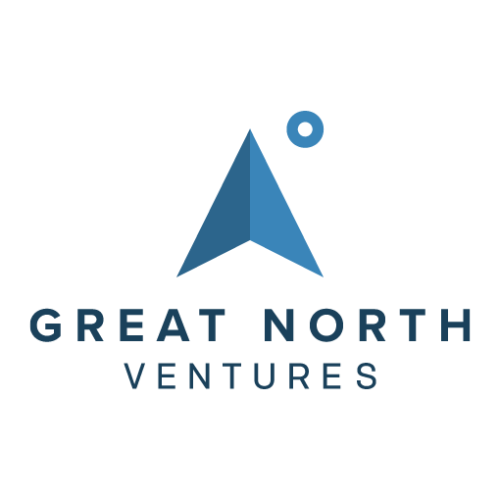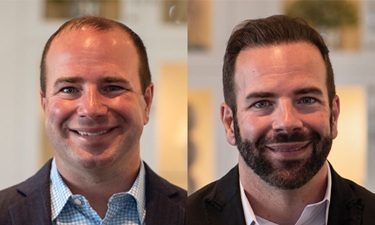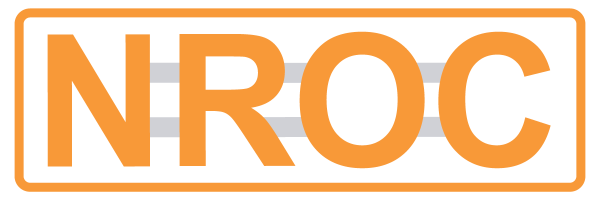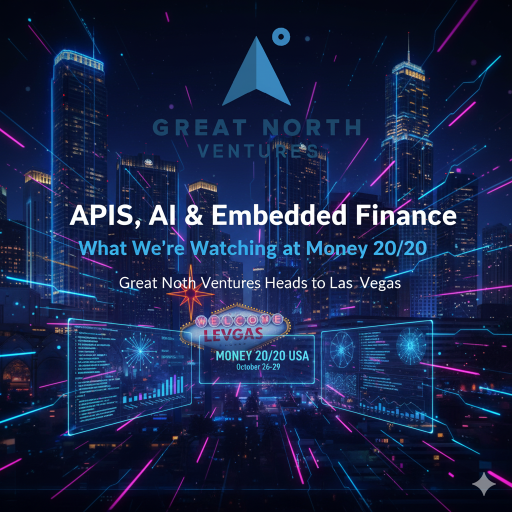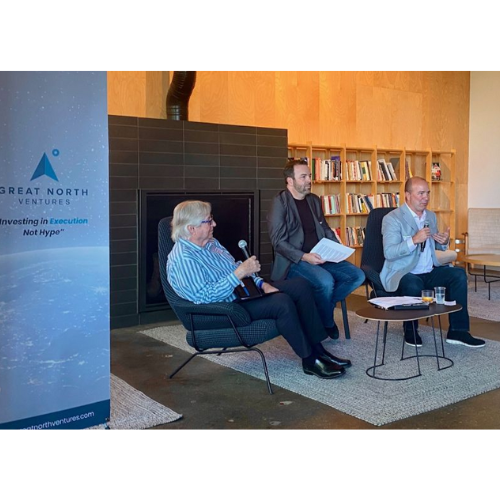by Graeme Thickins
For twin brothers Rob and Ryan Weber, founding partners of Great North Ventures in Minnesota, entrepreneurship began in college, just as the Internet was taking off in 1996. As computer science majors (and Rob later switching to entrepreneurial studies), they learned quickly that Internet traffic could be monetized. Over a few years, they built several websites that became profitable businesses before they even graduated.
They tell a favorite story. An LA company wanted to buy their business and flew them out. They’d never flown anywhere, and were too young to rent a car, so they brought along their mom, whom they introduced as their marketing consultant. But they decided not to sell. Why should they, when they were enjoying making lots of money, having come from humble beginnings? But their real passion was to continue building things no one else was doing. When the dot-com crash came in 2000, they were well positioned to weather the storm, having consolidated their businesses into a profitable entity that, being based in Minnesota, they playfully named Freeze.com.
This is the story of how they moved on from winning in that early tech cycle to master those that followed, and how they positioned themselves to win in what is now the biggest cycle of them all.
Investing in Others’ Ideas
In the early- to mid-2000s, not only were Rob and Ryan running their successful Freeze.com business, which grew to some 30 employees, but they soon became angel investors on the side, backing promising businesses they saw some of their peers starting. And that brought them rewards later when they realized exits from some of these investments. It was a harbinger of things to come, as they went on to became successful VCs in later years. (More on that soon.)
What happened just a few years after the dot-com era was the dawning of another huge cycle, driven of course by mobile technology — and most notably by the iPhone, beginning in 2007. The Webers’ business, which had by now adopted the name W3i, jumped on the opportunity to benefit from the explosion of opportunity that presented itself in mobile advertising.
Lessons Learned
Looking back, what did the Weber brothers learn from their experience in those first two tech cycles?
“In our high school to early college days, we spent 1996 to 2000 marketing our different websites, so that by the time we launched Freeze.com, we already had an in-depth understanding of how to grow an Internet publishing business efficiently,” said Rob. “While others were burning huge amounts of VC capital in the late ’90s, we were growing a bootstrapped publishing business built on a strong foundation. What really set us apart from other dot-com businesses at the time was our proprietary business intelligence system, which gave us a competitive advantage in optimizing traffic acquisition and site optimization, including proprietary A/B testing systems.”
“We were heavy users of performance data,” said Ryan. “We pushed the limits of data center capacity in the early 2000s, actually having to build out our own.” (Note: well before the cloud tech cycle.) “We ran thousands of experiments optimizing our website using A/B testing through our proprietary back-end publishing technology. That allowed us to dominate the category of free PC software versus other rivals for many years, leading to strong profitability. We built recommendation systems early-on using data we collected to optimize the performance of our website.”
Rob added: “When the dot-com bust occurred in 2000, the tide went out on thousands of VC-backed dot-com businesses. Those that survived and thrived were the ones that focused on iterating quickly and taking a very analytical approach to delivering efficient, lasting growth.” Freeze.com was indeed one of those.
Technology Was Paramount
Ryan Weber recounted lessons learned as the brothers built their expanded business, W3i, and leveraged the latest technology advances, including AI and ML (That business was later renamed NativeX.) “We recruited Dr. James Shanahan, a PhD in machine learning then affiliated with UC Berkeley. Under his guidance, we developed predictive advertising models that leveraged non-personally identifiable data we collected from our embedded SDK in popular iPhone and Google Play apps and games. Our prediction models were leveraged to increase conversion rates for our advertisers.”
NativeX’s ad tech allowed developers to make more money off their apps. For example, Sega was one gaming firm that partnered with NativeX to boost its mobile advertising revenue. “We operated in the mobile ad tech space,” said Rob. “There were hundreds of competitive companies. We had a successful exit — most didn’t. Applovin became one of the other big winners. Their team delivered incredibly high-performing AI models.”
Rob offers some insightful history in this regard. “Early on, Amazon performed extensive experimentation and A/B testing to optimize customer lifetime value. Unlike many competitors who focused on short-term profits, Amazon’s foundational ‘customer obsession’ and long-term perspective led it to make strategic bets on what would build loyalty and increase customer spending over time. This was similar to the system we built early on with Freeze.com. Obviously we didn’t achieve the scale of Amazon, but with a similar approach, we grew very fast and efficiently.”
In the early days of the App Store, which launched in 2008, the most common way to make money from an app was to charge for it, often 99 cents. “But just like with the web, over time it was the free apps that quickly went on to dominate the traffic on mobile,” said Rob. “And just like the Facebook games, which grew extremely quickly just prior to this time period, free-to-play games leveraging virtual currencies dominated the top-grossing charts in the App Store. We knew that not all popular free games and apps were great for driving demand for virtual currency, so we focused on creating a system to help games and apps that had poor monetization to make more money. Just like earlier when we focused on PC software categories that generated excessive amounts of traffic but that consumers were unwilling to pay for.”
Leveraging Some Heavyweight Experience
The Weber brothers never really needed outside investment as they grew their profitable businesses. But, in their journey to grow W3i / NativeX, they realized that taking some angel investment from certain key, longtime Silicon Valley tech execs, whom they had met, would bring value to their business. These investors became valuable advisors and mentors as the brothers expanded the business to 170 employees. They were successful operators who guided them at critical junctures. And they benefited when NativeX went on to be acquired in 2016.
“We also tapped the strength of the technology ecosystem here in our own state of Minnesota, in terms of managing and leading as a data-driven technology business,” said Ryan. This was as the mobile tech cycle was leading right into the cloud cycle. “We hired Andy Johnson as our CEO. Andy’s background as an executive at various companies gave him a front-row view of the world’s leading database marketing solutions and some of the organizational and business requirements to scale such a business, which was helpful to us for our digital advertising model.”
NativeX built the technology it needed and also leveraged other talent in the San Francisco Bay Area. With the aforementioned Dr. James Shanahan, an adjunct professor at Berkeley, Ryan said they were able to recruit top PhD students to work for them that were primarily looking to gain experience before commanding top market wages. The competition for this talent was fierce, Ryan recounts. “But the key was having a leader who was a competent mentor and coach. Shanahan was very personable, encouraging his team to be a part of the company and to fully engage in team-building activities. He knew the stakes were high and went out of his way to build and retain key talent. Also, Shanahan was active in the industry, striving to understand the state of the art. That included, extremely early-on, following advances in neural networks and their breakthrough uses of ‘deep learning’ – foundational research sparking massive interest in AI, which eventually spurned LLMs – and seeking to figure out the trajectory and potential for our business.”
“At W3i, we had only built our A/B testing capabilities internally, and we outsourced multi-variable optimization to companies that had capabilities using statistical and machine-learning systems, including one that came out of MIT,” said Ryan. “But as we evolved to NativeX, we required high-capacity systems that could train offline models, using statistical and machine-learning in an ensemble approach, which could then be deployed to make decisions based on predictions in less than 200 milliseconds. With NativeX, we essentially built an intelligent ad server for determining the effectiveness of ads served towards a targeted outcome for the advertiser.”
While NativeX was reaching its full potential in May 2014, VentureBeat, a tech innovation news outlet, ranked the Webers’ company No. 6 on a list of the top-10 most effective monetization companies. Fast forward, in February 2016, Mobvista announced plans to acquire NativeX as part of its global expansion in a deal reported to have paid gross proceeds of about $25 million in cash.
Moving On to Their Next Big Act
After NativeX was acquired, the Webers made a significant transition in their careers. With their notable success as operators in the dot-com cycle and, later, in the mobile and cloud tech cycles now behind them, they took some time to think about their next move.
“Ryan and I had been successful angel investors for 10 years at that point, but we had never talked about launching a fund until a year after we sold NativeX,” said Rob. “We had seen a small number of new VC funds spring up, and we felt we could deliver more value to founders by sharing our operational knowledge with them. We knew the operational guidance provided by most VC funds was shallow, because most general partners had never scaled a business before and lacked perspective.”
Startup founders will invariably say they prefer VCs who are former operators. They know they’ve been in their shoes. They’re very aware the road is far from easy. Like them, operator VCs have clawed their way through the tough times, pitched endlessly, suffered all the turn-downs, built teams, and struggled to get to product-market fit. The Weber brothers were confident that founders wanted investors who not only get all that, but have actually lived through it.
So, in 2017, the brothers embarked on the launch of their first VC fund, which they initially called Great North Labs (later changed to Great North Ventures). They ultimately raised just under $24 million for that first fund.
Was that transition from operator to VC difficult? Did the idea of pitching investors rather than customers mark a radical change for them? “We were blessed to find early support from limited partners who knew about our success as founders and angel investors from our prior 15-plus years of history with startups,” said Rob.
Looking back, Rob said: “If you had walked into our office while we were growing our W3i / NativeX business, on the walls throughout there were LCD screens with the KPIs for our budget and the KPIs related to our business. We knew hour by hour exactly how we were doing. I miss that part of it, the real-time operating aspect. You don’t get that in an investment business. As a VC, you don’t control businesses, you just own small percentages of your portfolio companies. But when you’ve seen things work and not work, you do get to make suggestions. That’s the value with an operator-led fund such as ours. We’ve been there.”
Ryan added: “Yes, we certainly provide mentoring and coaching as an operator-led fund. We also have many supporters who have scaled businesses. So, we’re serious about actively helping our founders, either ourselves or by tapping our supporters who have the right domain expertise. In addition, we have relationships with local talent and international talent, and that includes full-time, fractional, and agency-type contractor relationships. We know at which stage it would make sense to put any of these in the seat.”
Looking for the Best Founders
So, how do the Weber brothers agree on deciding to invest in a given startup? What key things do they look for?
Says Ryan: “At Great North, we’re founder-first and economics-driven. We back gritty, insight-led teams solving urgent problems in large markets.”
Rob adds this: “Number one, I’d say we look for ‘blue ocean’. Have the founders identified a new market space, or a new approach to an existing market, and become a ‘one-of-one’ company with no meaningful direct substitutes? Number two, we look for customer acquisition advantage. Companies that have identified an efficient way to scale.”
What are some key traits these VC brothers look for in a founder before investing? That was an easy response for Rob: “We like those that demonstrate speed of execution early on.”
And he expanded: “Another value we look for in entrepreneurs is accountability. By that, I mean don’t be a victim. Don’t let people tell you no. I think you’ll see this pattern with successful entrepreneurs. They’re going from zero to one with or without you, and you’re either on the bus or you’re off. But they’re doing it. They’re not waiting for someone to decide if they can do it. They’re doing it.”
When Ryan is asked his take, he has even more to say: “Grit plus velocity. Founders who are relentlessly resourceful, ship and learn fast, and show consistent weekly progress. We look for founders that have a clear, data-backed thesis and a deep empathy for the user and their problems.”
Finally, Ryan said. “We look for ‘talent and selling magnetism.’ Can they recruit A-players and win customers and partners with crisp, metrics-driven storytelling.”
Early Success Leads to Fund II
Great North Fund I, closed in 2018 at just under $24 million, has 15 remaining portfolio companies and is fully deployed, except for limited follow-on investments. Fund I breakout companies in Fintech and Proptech have achieved scale, and continue to grow very quickly and capital efficiently, including Branch and WithMe.
With the Webers’ background in publishing optimization, Great North has even invested in certain Media Tech companies, such as Featured.com and Pear Commerce.
The success of Fund I led to Great North Ventures closing its Fund II in 2022, at a much larger total of $41 million, with many new limited partners participating. That fund is now invested in 27 companies to date, with approximately $15 million of its funds remaining to be deployed, including as follow-on investments.
Now the Great North Ventures team also has its sights on the launch of Fund III. Stay tuned!
The Biggest Big Tech Cycle of All Now in Full Swing
Today, it’s quite clear the era of AI innovation is here and rapidly taking hold. Great North Ventures is actively investing what it sees as the best opportunities, positioning the firm for even more success in its role as an experienced investment partner. Its latest investment themes have focused on vertical AI applications, fintech, proptech, and enterprise productivity.
What’s an example of these themes that Great North Ventures sees today? And what are some portfolio companies leveraging these themes? “I’ve heard others cite ‘SaaS-plus’ – but I call it embedded finance,” said Rob. “The Total Addressable Market for many vertical software companies can appear small but, through embedding financial products, the expansion revenue can exceed the expectations of most. We first saw this with one of our earlier angel investments, FieldNation. We are now seeing similar expansion opportunities in companies in our portfolio like HLRBO. We also like to invest in the infrastructure companies that are supporting this trend, such as Yardstik and LendAPI, both also in our Great North Ventures portfolio.”
Inspired By Break-Out Startups
When judging a VC firm, one of course looks at the growth of the companies in its portfolio. That growth has been impressive for the Webers. It’s also informative to ask these twin brothers what inspires them to further success – namely, what’s a favorite break-out startup that’s not in your portfolio?
“I admire what the founders of Sezzle have been able to build,” Rob said. “From our earliest conversations with them, when they were just starting, they were adamant the existing Buy-Now-Pay-Later companies like Affirm and AfterPay were not serving under-banked consumers well. They found there was an enormous opportunity to use AI and other available data to make better credit decisions.” (Note: Sezzle was founded in Minnesota in 2016, and was just ranked the second-fastest growing public company in the state, up from 18th fastest the prior year.)
Ryan cites another one: “I admire Brad Dwyer at Roboflow from Des Moines, Iowa. He’s the archetypal ‘builder.’ He learns by shipping, turns frontier tech into practical workflows, and iterates ruthlessly from real user pain. He’s also a community catalyst and talent magnet, consistently expanding the circle around the company. This is a Midwest breakout that reflects the traits we prize.”
Where Great North Ventures Goes From Here
A recent study by MIT found a 95% failure rate by enterprises trying new Generative AI tools. Yet startups are succeeding by creating visible wins in narrow workflows, then expanding. The same study finds a 67% success rate in full deployment.
“Think in terms of the last mile of AI,” Rob Weber contends. “In this GenAI mega cycle, the startups that deliver immediate value are going to win.”
The Weber brothers are quick to identify the unique value proposition of their planned Great North Ventures Fund III. It is based on their team having demonstrated a successful entrepreneurial and investing track record through past mega innovation cycles – dot-com, mobile, and cloud – which gives them the unique ability to attract the top startups and talent fueling today’s mega-cycle: Generative AI. “The largest gains businesses are seeing from GenAI,” according to Rob Weber, “are coming from startups that are solving narrowly focused problems and expanding outwards. We believe these are ideal conditions for a small, vertically focused VC fund.”
As they look to continue their investment from Fund II, and from the future Fund III, Rob and Ryan define their firm as operator-investors focused on Vertical AI and Embedded Finance — a pairing they believe will produce the most capital-efficient, defensible companies of the next cycle. The firm’s sweet spot is seed-stage teams turning frontier capability into practical, measurable outcomes, fast. Great North is active in real estate/proptech, financial services (banking, payments, lending, insurance), and media/advertising tech – areas with clear pain, measurable outcomes, and fast commercialization. The firm invests both in full-stack vertical apps and in infrastructure that lets those apps embed finance safely and quickly.
Bottom line, they say: “We back founders who can ship, prove, and compound – turning AI into workflow, and workflow into durable fintech economics.”
———-
Graeme Thickins is a startup advisor and an investor in Great North Ventures Fund I. He is also an angel investor in two subsequent Great North portfolio companies. He has written previously for and about Great North Ventures and its founders over several years.
